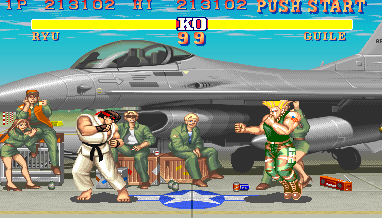Killer Instinct, Fighting Games, and the F2P challenge
A new Killer Instinct was announced at E3 as an Xbox One exclusive. It has also chosen to adopt the free to play model, something that other fighting game devs have been thinking about adopting for some time. Will this gamble pay off?

There has been a small schism in the fighting game community over the past year regarding the direction the community may take in the future. Half seem to wish to embrace the eSports ideology, complete with the sponsors and "legitimacy" it would bring. The other half mocks and derides eSports for the perceived fakeness of the term and the idea that it would corrupt the current FGC with its pretension, destroying the community spirit that kept the scene alive in the days before TwitchTV and Youtube.
Both sides have legitimate reasons for believing in what they do, and Killer Instinct throws another point of debate into the ring: free to play fighters.
Now, just to clarify, free to play fighters are nothing new. There have been a few in japan and the asian market in general, but none have ever made it to the US or had any substantial impact. A new version of Tekken just came out on PSN as free to play, but we've yet to see how that game will turn out. The question is, will this model work and what does it mean for the future of fighting games?
Everyone's after that League Money 
Making that League Money
I would not hesistate to say that this move is entirely inspired by the success of League of Legend's F2P model. They rake in an obscene amount of money for relatively little effort, an exteremly tempting target, as the recent explosion of free-to-play games has shown.
But this is fighting games we're talking about here, things are a little different. While details are scant, there are some things that the new Killer Instinct will have to figure out if they intend to follow through on the free to play model.
1. The Training Room Problem
One of the biggest features of modern fighting games is their inclusion of a training room. This isn't a series of tutorials, it's simply a stage where players are given the chance to experiment, set AI actions, and generally figure out how the game works.
Not having access to every character would neuter this essential feature. The training room isn't just meant to appeal to the hardest of the hardcore, it's an important tool in letting all players have fun with the game and figure out how all the systems of the game work. It's the place where combo junkies get their most enjoyment out of a game. Knowing that normal attack A will beat out normals B and C is the kind of thing that can elevate a player's understanding of the game dramatically. Yes, this is a free to play game, but it would feel like a key part of the fighting game experience would have been taken out. Oh, and speaking of the fighting game experience...
2. The casual fighting game player vs. the casual MOBA player
While some may disagree, the core success of a fighting game is due partly to its accessibility. It's part of the reason smash bros and UMVC3 have been such smashing hits, you can pick up a controller and know how to play and feel like you're kicking ass in minutes. The problem then occurs when plateuing starts to kick in and the general way that online environments work.
Take UMVC3 for example. On Xbox Live, unless you are a very skilled player with around 20 to 30 hours under your belt already just so that you're used to all the basic setups (and even then that might not be enough), you will be destroyed by the online competition. Online ranked play on XBL is not a healthy, constructive place to learn new characters or experiment, it promotes honing what you already know and figuring out how to counter it with the team or character you've chosen.
Fighting games aren't like League of Legends. It's hard to have flavor of the week characters because there's so much more to learn and there isn't the same kind of team composition metagame you'll find in LoL or DOTA. Sure, you can be astoundingly good with 2 or even 3 characters, or be all around amazing at the game enough to play everyone, but fighting games will demand time to become a character/team specialist once you reach a certain level and want to start winning. There's no way around this, not to mention the huge number of people who simply don't care enough to learn anyone besides Ryu or Ken. How many people are going to download KI just to play Jago and be fine with only playing as Jago? How do you make money when the majority of your player base doesn't feel the need to play any other characters?

A nuanced match...
Look at a character like Guile from the classic Street Fighter 2. He only has 2 special moves and a few command normals (normals + single directional input). It's not hard to actually do what you can do with Guile, he doesn't require the crazy execution that some characters do, but the only way to really win with Guile is through matchup experience and knowledge. That takes time, and when you've invested dozens of hours into learning how to play a character so that you don't get mauled online, it's hard to branch out and play other characters. There's even less incentive when you have to pay to unlock those other characters.3. Supporting the Tournament Scene
There are a few other questions that need to be answered. What will the new character introduction rate be? Will all characters be available for purchase at the start?
Remember, the key here is whether or not Double Helix, Konami, or Tecmo can actually make money off of this game, and the history of fighting games has shown that anything less than bending over backwards leads to failure, and even then that might not be enough. Look at a game like SFxT. It sold decently, but nowhere near the level Capcom was hoping for. Bad word of mouth, relegation to a second tier game at tournaments, and just the fact that it wasn't a fun game to play when it first released all came together to permanently mark SFxT as a game not worth playing. And when a game isn't worth the scene playing it, it's not worth buying.
The potential for free publicity is amazing, perhaps even greater than anything league is capable of. Imagine a character specialist taking a low tier pick all the way to win Canada Cup or another big tourney. I guarantee that character will be the number 1 download for the next month.
Now when I say tournament support, I don't mean just sponsoring events or teams, though that's a good part of it. Tournament support is both making the game easy for people to set up and play, something that plagued SFxT for a while. Tournament support is actively listening to fans and adjusting the game as the meta evolves. Tournament support is yearly or even bi-yearly version updates to keep the game fresh and changing. This is what players want, and it's what will make the game stand out in people's minds and make them loyal to playing it and supporting it. Capcom is starting to understand this, Netherrealms understands it, but Double Helix is poised to take it to the next level.

Get Hype, cause it's coming
This might seem like obsessing over small problems, but Double Helix Studios has said that they are committed to making this a tournament level game, which means really thinking about how their decisions and future plans will affect the game's longevity. Becoming a tournament level game is a bold claim, one that other games from more storied companies have tried to do and failed. Tekken Tag 2 and Soul Calibur have both largely fallen off the radar, as have anime fighters like Blazblue and Persona 4: Arena. They were perfectly fine, fun games, but they just couldn't gain the foothold of a game like Injustice. If Killer Instinct and these other F2P fighters succeed, it would be an amazing new step for fighting games. Heck, it's the game that made me start saving pennies for an Xbox One, an achievement in and of itself.
It would prove that the free to play model can work with yet another genre and open up fighting games to a huge number of people who otherwise might not be initially interested. Even if they don't become world-class players, just getting people to try it out, feel the excitement of playing, and tune in for major tournaments would be a huge victory not just for Killer Instinct, but for the entire fighting game genre. This could be the real step that fighting games need to finally break into League of Legends level numbers, to get the kind of viewers for majors that IPL League would draw in.
The Big Takeaways for Double Helix
Community and Tournament support will be key. Look at games like P4A and TTT2 and figure out what went wrong.
Don't be overly greedy or engage in shady business practices to sell more DLC. That always backfires the moment people catch wind of it.
Constant Content updates. A lot of people like Injustice for exactly this reason, Netherrealms frequently pushes updates and patches within days. This is a sign of dedication on your part and that your game is healthy. A healthy game with a vibrant community is what makes fighting games sell, it's what's kept UMVC3 at the top for the last few years.
If the game is boring, people won't play it, plain and simple. If there are problems or hideous gameplay imbalances, fix them immediately, people will give your game another chance. Capcom's slow reponse to SFxT's problems (along with a few other things) is what led to the death of that scene.
Read more about:
BlogsAbout the Author(s)
You May Also Like








